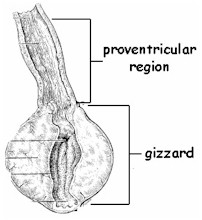Category: Stomach
-
Enterochromaffin (EC) cells aka Kulchitsky cells
Enterochromaffin (EC) cells (also known as Kulchitsky cells) are a type of enteroendocrine cell, and neuroendocrine cell. They reside alongside the epithelium lining the lumen of the digestive tract and play a crucial role in gastrointestinal regulation, particularly intestinal motility and secretion. They were discovered by Nikolai Kulchitsky. EC cells modulate neuron signalling in the enteric nervous system (ENS) via the secretion of the neurotransmitter serotonin and other peptides.…
-

The lactating birds and the bees (gastrin, pepsin, etc)
Crop milk is a secretion from the lining of the crop of parent birds that is regurgitated to young birds. It is found among all pigeons and doves where it is referred to as pigeon milk. An analog to crop milk is also secreted from the esophagus of flamingos and the male emperor penguin. Description Crop milk bears little physical resemblance to mammalian milk. Crop milk is a…
-
Ghrelin or lenomorelin
History and name Gene, transcription products, and structure Ghrelin cells Alternative names Location Features Function and mechanism of action Blood levels Ghrelin receptor Locations of action Glucose metabolism Sleep Reproductive system Fetus and neonate Anorexia and obesity Disease management Gastric bypass surgery See also External links Look up ghrelin in Wiktionary, the free dictionary. Hormones Peptides: neuropeptides Appetite…
-

Prolactin (PRL)
In mammals, prolactin is associated with milk production; in fish it is thought to be related to the control of water and salt balance. Prolactin also acts in a cytokine-like manner and as an important regulator of the immune system. It has important cell cycle-related functions as a growth-, differentiating- and anti-apoptotic factor. As a growth factor,…
-
Gastrin
Gastrin is a peptide hormone that stimulates secretion of gastric acid (HCl) by the parietal cells of the stomach and aids in gastric motility. It is released by G cells in the pyloric antrum of the stomach, duodenum, and the pancreas. Gastrin binds to cholecystokinin B receptors to stimulate the release of histamines in enterochromaffin-like cells, and it induces the insertion of K+/H+ ATPase pumps into the apical membrane of parietal cells (which…
Recent Posts
- 🧬 Disease Table with Low Sodium Connection
- 🧂 Sodium Reduction and Sodium Replacement: A History of Reformulation and Exploding Diseases, Including Many Diseases Unheard of Before Deadly Sodium Policies
- 🧂 The DEADLY 1500 mg Sodium Recommendation predates the WHO’s formal global sodium reduction push by nearly a decade (and it’s even worse than that)
- 🧬 What Is Beta-Glucuronidase?
- When Sugar Was Salt: Crystalline Confusion and the Covenant of Sweetness
Tags
ADAM ASPARTAME Birds Blood Bones Brain Bugs Cancer Columba Cows crystallography Death Death cults Eggs Etymology Gastrin Gold Growth hormone History Hormones Insulin Liver Mere Perplexity Metal Monkey Business Mythology Paracetamol Plants Poison Pregnancy Protein Religion Reproduction Rocks Salt Slavery Snakes Sodium the birds and the bees Thiocyanate Tobacco Tylenol Underworld Venom zinc
